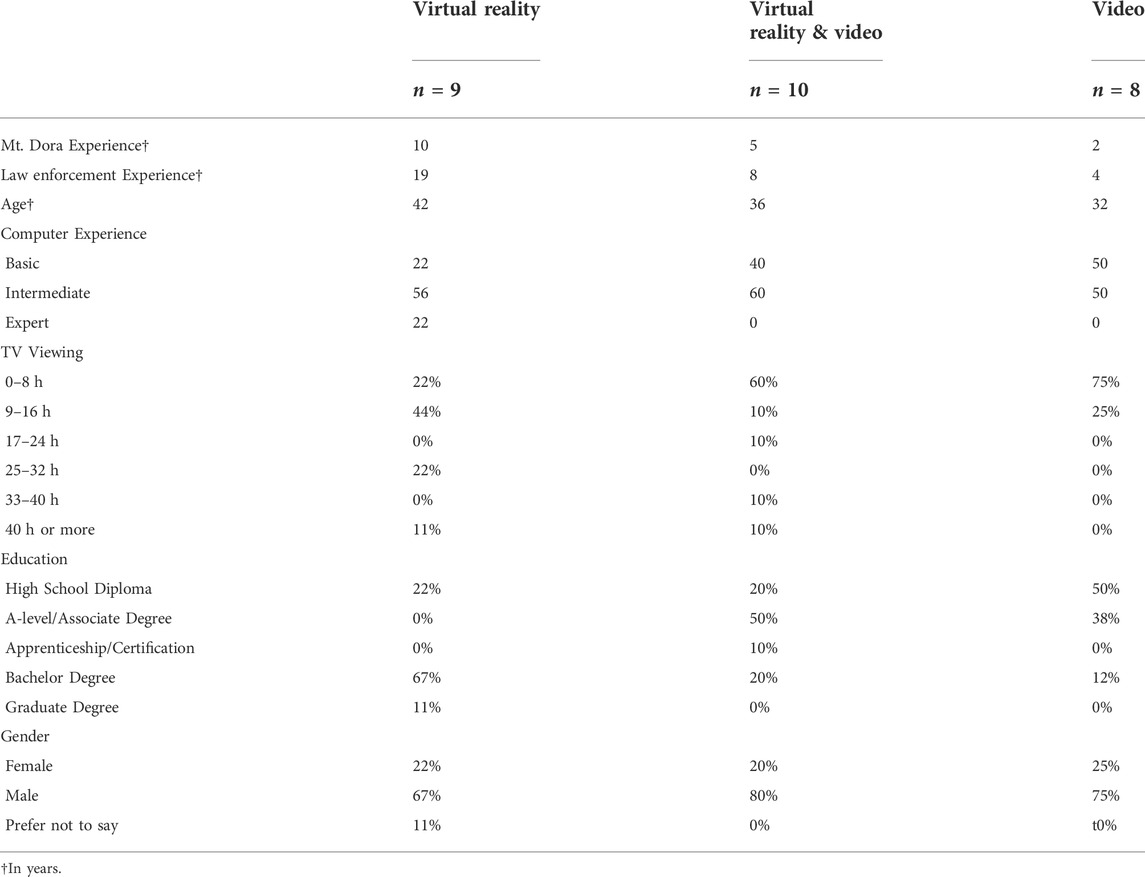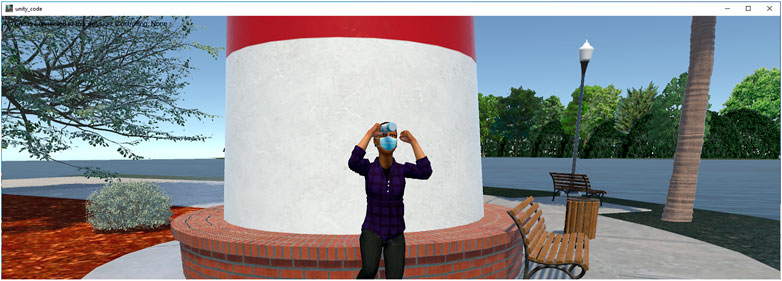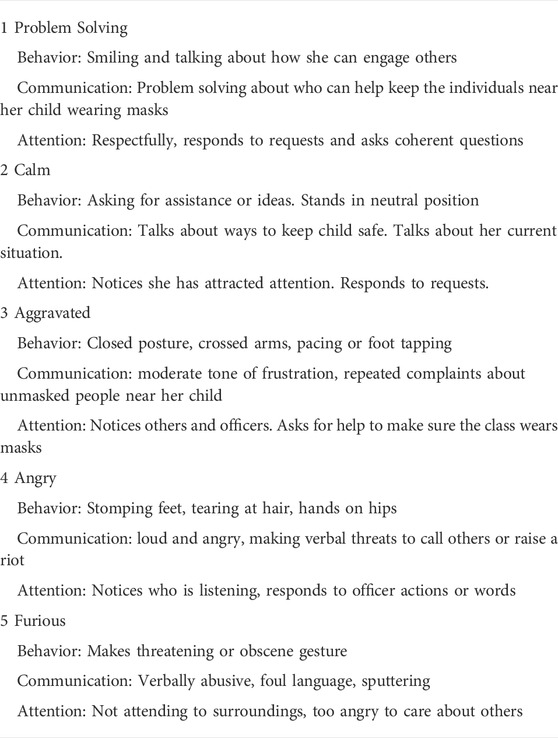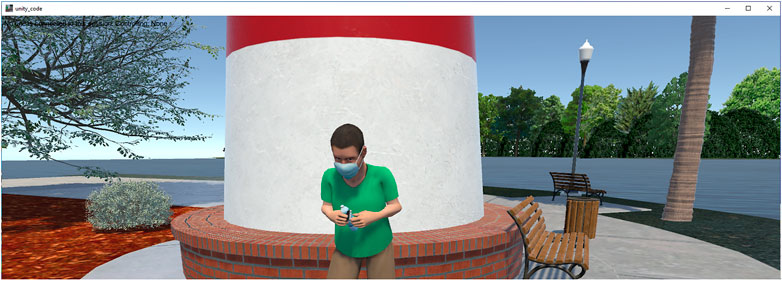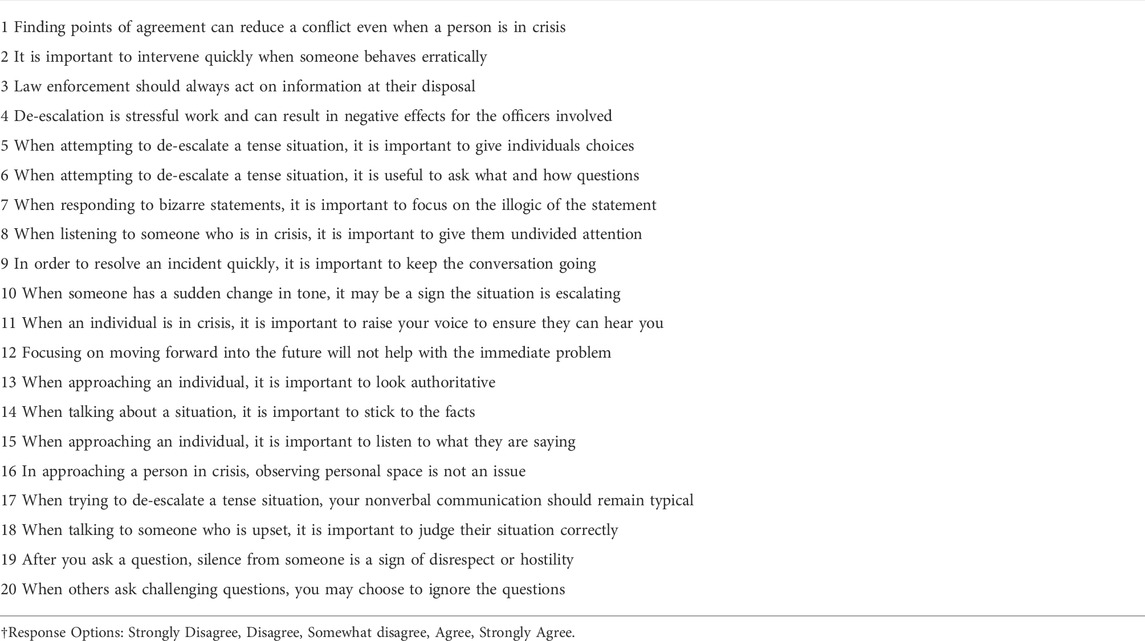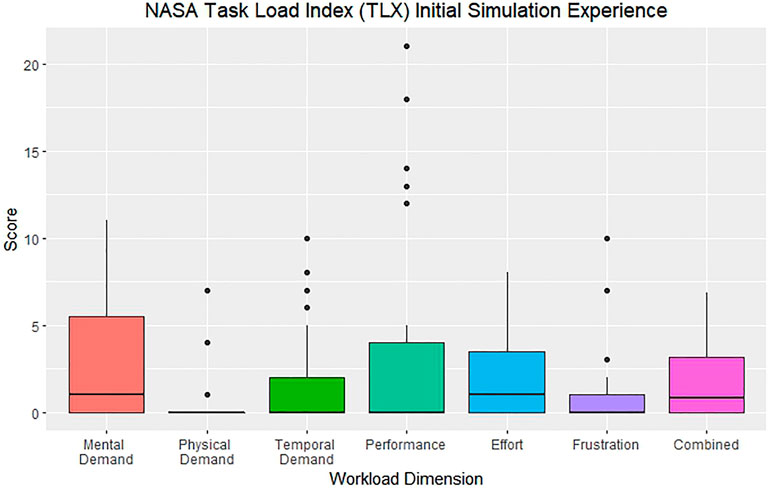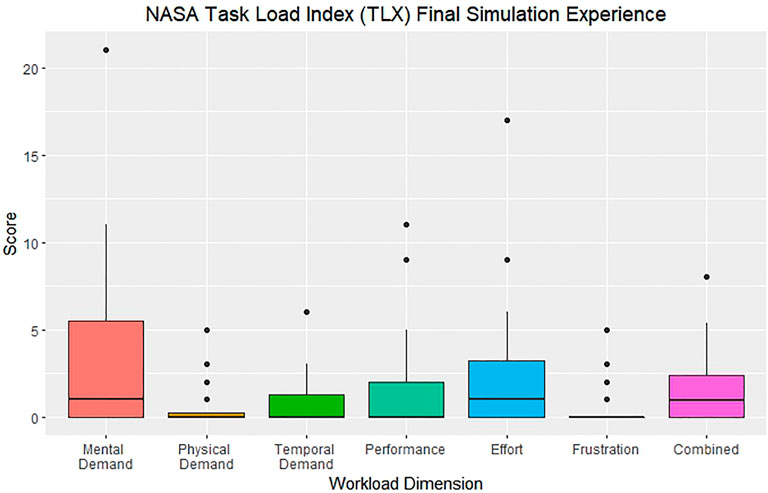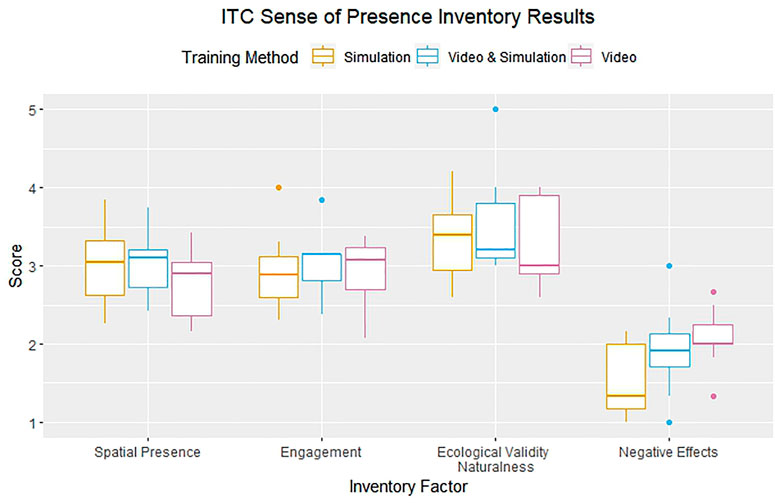- 1Synthetic Reality Laboratory, School of Modeling, Simulation, and Training, College of Graduate Studies, University of Central Florida, Orlando, FL, United States
- 2The MITRE Corporation, Orlando, FL, United States
- 3Department of Computer Science, College of Engineering and Computer Science, University of Central Florida, Orlando, FL, United States
Law enforcement professionals require up to date training for interacting with individuals on the autism spectrum in a manner that facilitates positive citizen response. Although these officers interact with the public regularly, they may only have sporadic interactions with citizens who are not neurotypical. The timing of these interactions is not easy to predict; therefore, it is important to provide regular opportunities to practice contacts with special needs communities. However, in much the same way that it can be difficult to provide regular sessions with other protected groups of people, it is not practical to pull individuals on the autism spectrum to participate in law enforcement training. Role play with neurotypical individuals and classroom training presenting facts about autism do little to prepare these officers for their real-world encounters. Virtual interactions with people on the autism spectrum allow officers to practice techniques without compromising the health and safety of the communities they serve. This paper presents results of a study comparing police training through experiences in virtual reality (VR) with video training regarding police interactions with individuals on the autism spectrum. Police officers in a municipal police department who participated in the study were divided into three groups for continuing training purposes. One group received video training, one group received practice in VR, and one group received training through both video and VR. The differences in training method did not result in significant differences in training effectiveness. However, subjective data did support the efficacy of practice in a virtual setting. This project addressed three important challenges with training in VR. First, the team needed to define the specifics of behavior and language that the simulated individuals would exhibit. Second, the VR had to be tailored to be relevant to the officers participating. Third and finally, the schedule for training delivery had to minimize the time that officers were away from their assigned duties. Officer feedback on their training experiences indicated the approach to these challenges was well-received. The primary research question is whether training in VR is any more effective that watching a training video.
1 Introduction
Virtual reality is used for training communication skills in diverse settings including healthcare (Carnell et al., 2022), situational awareness (Norouzi et al., 2021), teaching (Dieker et al., 2019), safety (Bhandari, 2019), and military activities (Seibert, 2012). In the late 1990s, police departments started making use of simulators to allow officers to train in scenarios involving use of force, including shooting scenarios (O'Neill, 1995; Ellis, 1999). In some cases, the scenarios used in these simulators were adapted from role play scenarios. Evaluations with the simulators indicated that more intense stressful encounters triggered a greater stress response in the officers using the simulator (Murphy, 2011).
Atkins and Norris (2012) found cognitive abilities and judgement decreased as stress levels increased. Working with the Royal Canadian Mounted Police, Armstrong et al. (2014) found stressful scenarios in simulators had biometric effects similar to those found in actual police encounters. Encounters in the simulators often focus on various types of criminal encounters which may involve decisions on appropriate use of force. As these encounters become more involved, the virtual reality they present may include a more diverse population who better represent the community.
Law enforcement encounters a changing set of community demographics. Keyes et al. (2012) report an increase in autism diagnosis for those born between 1992 and 2003. A change in the diagnostic criteria may explain some of the expansion of this population (King and Bearman, 2009), but it also amplifies the need for police departments to recognize people who may respond in nontypical ways while still being law abiding. Individuals may shutdown or turn away in response to direct questioning or commands to make eye contact. Failure to comply with requests may be due to physiological sensations rather than hostility.
Although police organizations discuss de-escalation and reducing the use of force, there is little consensus regarding the training appropriate to bring about these ends (PERF, 2012; IACP, 2020). Police officers receive limited training in de-escalation techniques or alternatives to use of force. Florida does not require ongoing training in de-escalation or mental health training for police officers (Apex Officer, 2021). However, individual agencies are able to develop their own standards and training requirements. In Mt. Dora, all the officers had received an initial one-hour course covering interactions with individuals on the autism spectrum. In addition, some of the officers had attended a forty-hour course in Crisis Intervention Training (CIT). Compton et al. (2011) found that officers training in CIT were less likely to escalate the use of force in an encounter with schizophrenics and perceived less effectiveness from the use of force.
The primary goal of the study was to investigate the feasibility of delivering de-escalation training to law enforcement using VR and determine if it was any more effective than delivering a high quality video on the same topic.
2 Methods
This study was conducted working with the Mt. Dora Police Department in Mt. Dora Florida. The department was looking for a means to provide follow up training in non-escalation/de-escalation practices especially suited for interactions with individuals on the autism spectrum. The chief believed the officers had a good grasp of de-escalation practices when engaging with neurotypical individuals but needed additional opportunities to consider how to approach those who may present atypically.
2.1 Overall design
In designing this study, two different approaches to training were created for the Mt. Dora Police Department. One option is a high-quality video, and the alternative is a virtual reality experience. This study compares de-escalation training addressing individuals on the Autism spectrum using these two approaches. Active-duty officers who participated were divided into three treatment conditions. The first group participated in the virtual reality training session. The second group watched the video and engaged in the virtual reality session. The third group only watched the video. Table 1 below shows demographic statistics for the participants. It should be noted that condition 3, video only, has participants who were somewhat younger and have less policing experience. This arose despite a random assignment to the three conditions.
Each participant attended two sessions. Activities during the first session included familiarization with the virtual reality environment, a set of surveys, and the training exercise. The Independent Television Commission (ITC) Sense of Presence Inventory (SOPI) was completed by the officers after the training exercise. This survey instrument has been used for various types of simulation, video, and for reading material to look at how immersive and engaged people are with the material they are experiencing (Lessiter et al., 2001). The second session included a culminating virtual reality session and follow up surveys. Pre and post surveys compared responses concerning de-escalation approaches. The NASA TLX (Task Load Index) survey (Hart and Staveland, 1988) was used to examine workload during the virtual reality sessions.
2.2 First session
The first session had two goals main goals, familiarization with the technology in use and the training activity. The sessions were conducted over Zoom and many of the participants had not used the application before. They were also unfamiliar with controls for muting the microphone and silencing speakers when needed. Within the Zoom session the officers were placed in breakout rooms for the VR experience. To familiarize the participants with the VR, the officers used the Stacy scenario described below.
At the start of their first session, participants took a survey regarding their opinions on some points in de-escalation. Then everybody, regardless of the group they were in, had the opportunity to experience the virtual reality environment. The next section describes the details of the environment. The introductory session is referred to as the Stacey scenario. The Stacey scenario involves interacting with a woman who is standing in a public arena complaining about students not being required to wear masks in school. It is called in as an instance of possibly disturbing the peace and the officers are expected to deescalate the situation while maintaining their own safety and that of others in the area. Due to resource constraints, the officers were paired for the scenario. This scenario provided an opportunity for officers to familiarize themselves with the simulator and the technology they were using. Figure 1 provides a view of the character in the Stacey scenario. Table 2 provides levels of behavior exhibited by Stacy in response to officer interactions. Stacy starts at level 3, agitated.
Following the Stacey scenario each individual officer completed a NASA TLX survey to measure the workload experienced during the simulation. The officers then provided their individual demographic information. Following those two surveys, the officers participated in their training activity. Paired officers received the same training activity. The officers were placed in training activities based on their order of arrival at the session. Again, the individuals who were working with the virtual reality environment participated in pairs because of the limited resources with the simulator. For the video only, participation was in pairs to maintain consistency.
At the conclusion of their training, each officer completed ITC-SOPI regarding their experience in the training activity. This survey instrument has four factors that measure engagement, spatial presence, naturalness, and negative effects. The participants respond to survey questions regarding their experience with the training activity. These responses are then grouped to create a score for each factor (Lessiter et al., 2001).
2.3 Training content
The goal of the training is to support officers in interactions with individuals who have autism. In that effort the video gave explicit instructions to avoid close physical proximity, direct eye contact, physical contact, and overly stimulating environments. The avatar in the virtual setting will escalate if the officers attempt to make direct eye contact or reduce the physical distance. The avatar deescalates, moves lower on the levels of behavior, when the officer does the following:
• Encourages them to explain what has happened
• Maintains physical distancing
• Provides assistance with problem solving
• Offers binary choices rather than a list of options
• Encourages them to do an action rather than stop doing an action
These are behaviors that are regarded as useful in working with individuals on the autism spectrum and may not be appropriate in all law enforcement encounters.
2.4 Virtual reality experience
TeachLivE is a virtual learning environment originally designed for providing professional training to secondary school teachers (Dieker et al., 2019). Realtime interaction with virtual avatars is provided through software enabling digital puppeteering by trained human actors called interactors. In the original environment the avatars were in a classroom environment. For this study the virtual reality experience was tailored for Mount Dora by placing the avatars in a public setting in Mount Dora where officers might be expected to respond to a call for assistance. This setting was well known to the officers participating and they recognized it when entering the virtual reality. While the original virtual learning environment was delivered via projection to a life-sized screen, for the purposes of this study the virtual environment was delivered over Zoom on the screen the officers had available. Both the virtual reality setting and the method of delivery encouraged participant engagement and a sense of relevance to their work.
2.5 Video training experience
A ten-minute training video was created for this study. The video is set in Mount Dora and includes some members of the Mount Dora Police Department in the footage. Officers who viewed the video could recognize the settings. Several participants expressed the thought that the training must be applicable to their work because it was filmed in their town. The video explicitly states the training content described in Section 2.3. Scenes contain actors familiar with behaviors characteristic of autism who go through problems often encountered in public. These problems include ways the police can help resolve the issues without using force to coerce the individual.
2.6 Second session
There was a two-week gap between the first session and the second session. At the second session, the officers in pairs did the Martin scenario in the virtual reality environment. The Martin scenario involves a similar report of an individual behaving oddly and upsetting others in the same physical setting as the Stacey scenario. Although they are not made aware of it at the call, the officers are being asked to respond to an individual on the autism spectrum. They need to find out why this person is acting in an unusual manner, not necessarily protesting anything, but help the person to resolve their quandary. In the scenario design, Martin has become separated from his sister and, if he can be calmed down, he actually can remember where his sister has parked the car that they’re going home in and he has his sister’s phone number, but he needs to be calm enough to be able to access and make use of that information. Escalating and de-escalating behaviors for Martin were designed through discussions with autism experts in the UCF Center for Autism and Related Disabilities (CARD). Figure 2 provides a view of the character in the Martin scenario. Table 3 provides levels of behavior for Martin. Martin starts at level 3, agitated.
After the scenario, the officers again completed the NASA TLX survey and then they repeated the de-escalation survey. The responses regarding de-escalation were designed for pairwise comparison with the answers given prior to the training. These questions are provided in Table 4. Finally, participants responded to open-ended questions regarding their feelings and responses on the training.
3 Results
A total of 33 officers participated in the training activity. Of these there were five who attended the first session but not the second and one who attended the second session and obtained the training but did not complete the first session. These six officers are included in the NASA TLX workload summaries and the ITC-SOPI results, but they are not included in the pairwise comparison of de-escalation practices.
Figure 3 summaries the workload dimensions for the initial scenario. The seven dimensions of workload are shown on the x-axis and the y-axis has a score ranging from 0 to 21 based on officer survey response. The officers were using this scenario to familiarize themselves with the simulator prior to the training. In general, the scores are on the lower half for each dimension. It would appear some of the workload decreases after the training. This may be the result of familiarity with the simulation, but it may also be an artefact of using the same scenario for the final run as was used for the training sessions. The post training workload results are shown in Figure 4.
Figure 5 shows the results of the ITC-SOPI for the three different training approaches. The instrument has four factors: spatial presence, engagement, ecological validity (naturalness) and negative effects. The scores tend to hover around the midpoint for all three training approaches except for the negative effects score. Negative effects from the simulator were lower than the other two approaches. Further analysis of the negative effects scores using a one-way ANOVA yields a relatively low p-value of 0.02. This indicates the effects are likely due to the training method which may reflect the novelty of the simulation compared to the training video.
Finally, a pairwise comparison in de-escalation responses before and after the training was conducted. Using R, a Wilcoxon pairwise analysis was computed for each question in the survey. The resulting p-values did not indicate a statistically significant change for any particular question. To see if there was a significant change as a result of any particular training approach, the analysis was repeated for each approach. Again, none of the changes reach the level of statistical significance.
4 Discussion and future directions
The survey questions were devised prior to any specific training curriculum and without reference to the autism spectrum. As there does not appear to be a commonly accepted set of skills or techniques for de-escalation in the law enforcement community (Todak and James, 2018; Bennell et al., 2020; Engel et al., 2020), these questions cannot be said to measure an officer’s skill level. They are an attempt to consider some aspects of de-escalation approaches that have been expounded in other areas and that may be useful to law enforcement. Further work on measurable aspects of de-escalation tactics is underway outside of this study (Giacomantonio et al., 2020; Peterson et al., 2020; Bennell et al., 2022; Engel et al., 2022). Therefore, lack of change in the survey responses does not indicate the training was ineffective. Other means are necessary to judge the effectiveness of this training. The negative effects score being lower for the simulation is an interesting result. Many of the training sessions for the police department are done as slide presentations and it was expected that the simulator would be preferred to another presentation. The negative effects evaluated included items like feeling tired, disoriented, or having a headache. It was not expected that the simulator would have fewer physical effects than watching a video.
The initial simulation session and the final simulation session were recorded. These videos will be coded and compared to see if the training produced changes in expressions or specific word choices. The intention is to look at the number of times the officer makes eye contact, requests eye contact, smiles, asks open ended questions, and gives verbal commands. The time each group spent in the final simulation will also be measured and compared across the three training conditions.
The original experiment intended to use a more complex scenario for the final simulation. Unfortunately, there were technical difficulties in running the scenario during the time scheduled for this research. There are plans to do a follow-up session with the Mt. Dora Police Department using the more complex scenario now that the technical challenges have been resolved. This will likely be a group session and individual results will not be collected. However, it will be useful to gauge officer response to the revised scenario in order to guide future research and training.
Overall comments from all participants were very positive. Many people expressed a positive response to the timeliness of the training saying they had been encountering more individuals who appeared to be on the autism spectrum, and they were optimistic that more knowledge of this community would help them in their encounters. Others responded positively to the setting of the training scenario indicating that they felt it was targeted to their own needs and experiences because it was set in a familiar location.
5 Conclusion
Despite growing public cries for providing law enforcement training in de-escalation, there remains little research into how to best provide this training. Specific tactics and techniques across the wide spectrum of police encounters. Law enforcement officers respond favorably to training that targets the types of encounters they consider part of their working environments. Additional research is needed to determine the best way to tailor training depending on the tactics and techniques that are most useful for each department.
This study looked at a specific municipality and a defined population to attempt to provide additional information that would help the officers in interacting with these individuals during a crisis situation. Training which included the use of virtual reality to allow officer interaction had a more positive response than video training. Making use of the techniques did not significantly increase officer perceived workload in the virtual environment.
Data availability statement
The raw data supporting the conclusion of this article will be made available by the authors, without undue reservation.
Author contributions
JK conducted the training sessions and performed the data analysis. CH is a stakeholder in TeachLivE and had developed police training scenarios with the Mount Dora Chief of Police prior to this study. Both authors contributed to the design of the study and the authoring of the article.
Funding
This research was supported in part by a scholarship from the I/ITSEC conference and by grants from the National Science Foundation Grants # 2120240, 2114808, 1725554, and from the U.S. Department of Education Grants #P116S210001, H327S210005, H327S200009H Any opinions, findings, and conclusions or recommendations expressed in this material are those of the authors and do not necessarily reflect the views of the sponsors.
Acknowledgments
The authors would like to thank Chief Brett Meade and the Mount Dora Police Department for their support of this study. Special thanks to Neal Anderson, Scott Renaux, Jack Andreano, Chelsea Elliss, Elizabeth Krueger, Colyn Pell, Rochell Pell, Jim Logsdon, Kim Spence and Erin Imhof for their work on the video used in this study. None of this would have been possible without the artistic skills of Eric Imperiale, the interactive performance capabilities of Kathleen Ingraham, or the support provided by the TeachLivE team at UCF. Also, thanks to K-9 Mac for participation in the training and the video despite not being able to complete the surveys.
Conflict of interest
The authors declare that the research was conducted in the absence of any commercial or financial relationships that could be construed as a potential conflict of interest.
Publisher’s note
All claims expressed in this article are solely those of the authors and do not necessarily represent those of their affiliated organizations, or those of the publisher, the editors and the reviewers. Any product that may be evaluated in this article, or claim that may be made by its manufacturer, is not guaranteed or endorsed by the publisher.
References
Apex Officer (2021). Police training requirements. Available: https://www.apexofficer.com/police-training-requirements (Accessed 30 12, 2021).
Armstrong, J., Clare, J., and Plecas, D. (2014). Monitoring the impact of scenario-based use-of-force simulations on police heart rate: Evaluating the royal Canadian mounted police skills refresher program. West. Criminol. Rev. 15 (1), 51–59.
Atkins, V., and Norris, W. A. (2012). “Innovative law enforcement training: Blended theory, technology, and research,” in Police organization and training: Innovations in research and practice. Editors M. R. Haberfeld, C. A. Clarke, and D. L. Sheehan (New York and Heidelberg: Springer), 45–63. doi:10.1007/978-1-4614-0745-4_4
Bennell, C., Blaskovits, B., Jenkins, B., Semple, T., Khanizadeh, A.-J., Brown, A. S., et al. (2020). Promising practices for de-escalation and use-of-force training in the police setting: A narrative review. Pijpsm 44, 377–404. doi:10.1108/PIJPSM-06-2020-0092
Bennell, C., Jenkins, B., Blaskovits, B., Semple, T., Khanizadeh, A.-J., Brown, A. S., et al. (2022). Knowledge, skills, and abilities for managing potentially volatile police-public interactions: A narrative review. Front. Psychol. 13, 1–16. doi:10.3389/fpsyg.2022.818009
Bhandari, S. (2019). Leveraging emotional engagement techniques and adult learning principles to transform safety training. CU Scholar.
Carnell, S., Gomes De Siqueira, A., Miles, A., and Lok, B. (2022). Informing and evaluating educational applications with the kirkpatrick model in virtual environments: Using a virtual human scenario to measure communication skills behavior change. Front. Virtual Real. 3, 1–17. doi:10.3389/frvir.2022.810797
Compton, M. T., Demir Neubert, B. N., Broussard, B., McGriff, J. A., Morgan, R., and Oliva, J. R. (2011). Use of force preferences and perceived effectiveness of actions among Crisis Intervention Team (CIT) police officers and non-CIT officers in an escalating psychiatric crisis involving a subject with schizophrenia. Schizophr. Bull. 37 (4), 737–745. doi:10.1093/schbul/sbp146
Dieker, L. A., Straub, C., Hynes, M., Hughes, C. E., Bukathy, C., Bousfield, T., et al. (2019). Using virtual rehearsal in a simulator to impact the performance of science teachers. Int. J. Gaming Computer-Mediated Simulations (IJGCMS) 11 (4), 1–20. doi:10.4018/IJGCMS.2019100101
Ellis, R. (1999). Bang! You're sorta dead; virtual life and death: A computer simulation trains police in street judgment and shooting skills. Report.
Engel, R. S., Corsaro, N., Isaza, G. T., and McManus, H. D. (2022). Assessing the impact of de‐escalation training on police behavior: Reducing police use of force in the Louisville, KY Metro Police Department. Criminol. Public Policy 21 (2), 199–233. doi:10.1111/1745-9133.12574
Engel, R. S., McManus, H. D., and Herold, T. D. (2020). Does de‐escalation training work? Criminol. Public Policy 19 (3), 721–759. doi:10.1111/1745-9133.12467
Giacomantonio, C., Goodwin, S., and Carmichael, G. (2020). Learning to de-escalate: Evaluating the behavioural impact of verbal judo training on police constables. Police Pract. Res. 21 (4), 401–417. doi:10.1080/15614263.2019.1589472
Hart, S. G., and Staveland, L. E. (1988). Development of NASA-TLX (Task Load Index): Results of empirical and theoretical research. New York, NY: Elsevier Science Publishing Company, Inc.
IACP (2020). National consensus discussion paper on use of force and consensus policy. AvaliableAt: https://www.theiacp.org/resources/document/national-consensus-discussion-paper-on-use-of-force-and-consensus-policy.
Keyes, K. M., Susser, E., Cheslack-Postava, K., Fountain, C., Liu, K., and Bearman, P. S. (2012). Cohort effects explain the increase in autism diagnosis among children born from 1992 to 2003 in California. Int. J. Epidemiol. 41 (2), 495–503. doi:10.1093/ije/dyr193
King, M., and Bearman, P. (2009). Diagnostic change and the increased prevalence of autism. Int. J. Epidemiol. 38 (5), 1224–1234. doi:10.1093/ije/dyp261
Lessiter, J., Freeman, J., Keogh, E., and Davidoff, J. (2001). A cross-media presence questionnaire: The ITC-sense of presence inventory. Presence Teleoperators Virtual Environ. 10 (3), 282–297. doi:10.1162/105474601300343612
Norouzi, N., Bruder, G., Erickson, A., Kim, K., Bailenson, J., Wisniewski, P. J., et al. (2021). Virtual animals as diegetic attention guidance mechanisms in 360-degree experiences. IEEE Transactions on Visualization and Computer Graphics 27 (11), 4321–4331. doi:10.1109/TVCG.2021.3106490
O'Neill, L. (1995). West covina simulators train police in field tactics. Los Angeles: Los Angeles Times.
PERF (2012). “An integrated approach to de-escalation and minimizing use of force 2012.pdf,” in Critical issues in policing (Washington, D.C: Police Executive Research Forum).
Peterson, J., Densley, J., and Erickson, G. (2020). Evaluation of 'the R-Model' crisis intervention de-escalation training for law enforcement. Police J. 93 (4), 271–289. doi:10.1177/0032258x19864997
Seibert, M. K. (2012). Addressing Army Aviation collective training challenges with simulators and simulations capabilities. Available: http://www.dtic.mil/get-tr-doc/pdf?AD=ADA565888.
Keywords: social interaction simulator, autism spectrum disorder, law enforcement training, social skills practice, virtual reality police training, de-escalation training in virtual reality, police scenarios in virtual reality
Citation: Kent JA and Hughes CE (2022) Law enforcement training using simulation for locally customized encounters. Front. Virtual Real. 3:960146. doi: 10.3389/frvir.2022.960146
Received: 02 June 2022; Accepted: 28 July 2022;
Published: 06 September 2022.
Edited by:
Christos Mousas, Purdue University, United StatesReviewed by:
Esperanza Johnson, University of Castilla-La Mancha, SpainFrancesco Chinello, Aarhus University, Denmark
Copyright © 2022 Kent and Hughes. This is an open-access article distributed under the terms of the Creative Commons Attribution License (CC BY). The use, distribution or reproduction in other forums is permitted, provided the original author(s) and the copyright owner(s) are credited and that the original publication in this journal is cited, in accordance with accepted academic practice. No use, distribution or reproduction is permitted which does not comply with these terms.
*Correspondence: Julie A Kent, amFrZW50QGtuaWdodHMudWNmLmVkdQ==
 Julie A Kent
Julie A Kent Charles E Hughes
Charles E Hughes